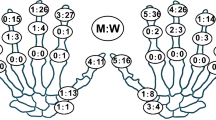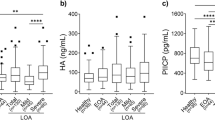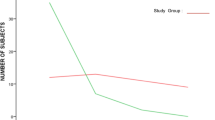Abstract
Purpose
Although serum hyaluronan (HA) levels increase in patients with osteoarthritis (OA), the association between OA severity and elevation of serum HA levels is not clear. Our purpose was to investigate the relationship between serum HA levels and OA in various anatomical sites and to detect which joints are strongly correlated with elevated serum HA levels.
Methods
Seven hundred and ten individuals from the general population who participated in the Iwaki Health Promotion Project in 2008 were involved. Kellgren–Lawrence grade 2 or higher in the knee, hip, lumbar spine, finger and wrist was defined as OA. Serum HA levels were determined on the same day. Spearman’s correlation coefficients between serum HA levels and total number of joints affected by OA were calculated. Linear regression was analysed with serum HA levels as the independent variable; age, gender, presence of OA and intake of supplements were used as dependent variables.
Results
Prevalence of knee OA was 30.7 %, hip 16.8 %, lumbar spine 65.1 %, wrist 9.0 % and finger 22.0 %. Serum HA levels had a positive correlation with the number of involved joints, and the correlation coefficient was 0.410 (p < 0.001). Serum HA was significantly affected by age (β = 0.382), knee OA (β = 0.163) and finger OA (β = 0.164).
Conclusion
Although this biomarker reflects a systemic condition, higher serum HA levels were associated with total number of OA joints. Knee and finger OA were key joints related to increased serum HA levels. These results are valuable in understanding characteristics of serum HA levels as a biomarker for osteoarthritis.




Similar content being viewed by others
References
Lawrence RC, Helmick CG, Arnett FC, Deyo RA, Felson DT, Giannini EH, Heyse SP, Hirsch R, Hochberg MC, Hunder GG, Liang MH, Pillemer SR, Steen VD, Wolfe F (1998) Estimates of the prevalence of arthritis and selected musculoskeletal disorders in the United States. Arthritis Rheum 41:778–799
Kellgren JH, Lawrence JS (1958) Osteo-arthrosis and disk degeneration in an urban population. Ann Rheum Dis 17:388–397
Woolf AD, Pfleger B (2003) Burden of major musculoskeletal conditions. Bull World Health Organ 8:646–656
Bedson J, Croft PR (2008) The discordance between clinical and radiographic knee osteoarthritis: a systematic search and summary of the literature. BMC Musculoskelet Disord 9:116
Ishijima M, Watari T, Naito K, Kaneko H, Futami I, Yoshimura-Ishida K, Tomonaga A, Yamaguchi H, Yamamoto T, Nagaoka I, Kurosawa H, Poole RA, Kaneko K (2011) Relationships between biomarkers of cartilage, bone, synovial metabolism and knee pain provide insights into the origins of pain in early knee osteoarthritis. Arthritis Res Ther 13:R22
Poole AR, Witter J, Roberts N, Piccolo F, Brandt R, Paquin J, Baron M (1990) Inflammation and cartilage metabolism in rheumatoid arthritis. Studies of the blood markers hyaluronic acid, orosomucoid, and keratan sulfate. Arthritis Rheum 33:790–799
Garnero P, Piperno M, Gineyts E, Christgau S, Delmas PD, Vignon E (2001) Cross sectional evaluation of biochemical markers of bone, cartilage, and synovial tissue metabolism in patients with knee osteoarthritis: relations with disease activity and joint damage. Ann Rheum Dis 60:619–626
Filková M, Senolt L, Braun M, Hulejová H, Pavelková A, Sléglová O, Kupka K, Gatterová J, Pavelka K (2009) Serum hyaluronic acid as a potential marker with a predictive value for further radiographic progression of hand osteoarthritis. Osteoarthr Cartil 17:1615–1619
Hosogane N, Watanabe K, Tsuji T, Miyamoto T, Ishii K, Niki Y, Nakamura M, Toyama Y, Chiba K, Matsumoto M (2012) Serum cartilage metabolites as biomarkers of degenerative lumbar scoliosis. J Orthop Res 13. doi:10.1002/jor.22067
Turan Y, Bal S, Gurgan A, Topac H, Koseoglu M (2007) Serum hyaluronan levels in patients with knee osteoarthritis. Clin Rheumatol 26:1293–1298
Inoue R, Ishibashi Y, Tsuda E, Yamamoto Y, Matsuzaka M, Takahashi I, Danjo K, Umeda T, Nakaji S, Toh S (2011) Knee osteoarthritis, knee joint pain and aging in relation to increasing serum hyaluronan level in the Japanese population. Osteoarthr Cartil 19:51–57
Golightly YM, Marshall SW, Kraus VB, Renner JB, Villaveces A, Casteel C, Jordan JM (2011) Biomarkers of incident radiographic knee osteoarthritis: do they vary by chronic knee symptoms? Arthritis Rheum 63:2276–2283. doi:10.1002/art.30412
Pavelka K, Forejtová S, Olejárová M, Gatterová J, Senolt L, Spacek P, Braun M, Hulejová M, Stovícková J, Pavelková A (2004) Hyaluronic acid levels may have predictive value for the progression of knee osteoarthritis. Osteoarthr Cartil 12:277–283
Engström-Laurent A, Laurent UB, Lilja K, Laurent TC (1985) Concentration of sodium hyaluronate in serum. Scand J Clin Lab Invest 45:497–504
Rössler A, László Z, Kvas E, Hinghofer-Szalkay HG (1998) Plasma hyaluronan concentration: no circadian rhythm but large effect of food intake in humans. Eur J Appl Physiol Occup Physiol 78:573–577
Hopman-Rock M, Odding E, Hofman A, Kraaimaat FW, Bijlsma JW (1997) Differences in health status of older adults with pain in the hip or knee only and with additional mobility restricting conditions. J Rheumatol 24:2416–2423
Buchman AS, Shah RC, Leurgans SE, Boyle PA, Bennett DA (2010) Musculoskeletal pain and incident disability in community-dwelling older adults. Arthritis Care Res 62:1287–1293
Engström-Laurent A (1989) Changes in hyaluronan concentration in tissues and body fluids in disease states. CIBA Found Symp 143:233–240, discussion 240-7, 281-5
Kellgren JH, Lawrence RC (1957) Radiological assessment of osteo-arthrosis. Ann Rheum Dis 16:494–502
Wells AF, Klareskog L, Lindblad S, Laurent TC (1992) Correlation between increased hyaluronan localized in arthritic synovium and the presence of proliferating cells. A role for macrophage-derived factors. Arthritis Rheum 35:391–396
Fraser JR, Laurent TC, Laurent UB (1997) Hyaluronan: its nature, distribution, functions and turnover. J Intern Med 242:27–33
Hällgren R, Engström-Laurent A, Nisbeth U, Circulating hyaluronate (1987) A potential marker of altered metabolism of the connective tissue in uremia. Nephron 46:150–154
Valva P, Casciato P, Diaz Carrasco JM, Gadano A, Galdame O, Galoppo MC, Mullen E, De Matteo E, Preciado MV (2011) The role of serum biomarkers in predicting fibrosis progression in pediatric and adult hepatitis C virus chronic infection. PLoS One 6:e23218
Emlen W, Niebur J, Flanders G, Rutledge J (1996) Measurement of serum hyaluronic acid in patients with rheumatoid arthritis: correlation with disease activity. J Rheumatol 23:974–978
Kraus VB, Kepler TB, Stabler T, Renner J, Jordan J (2010) First qualification study of serum biomarkers as indicators of total body burden of osteoarthritis. PLoS One 5:e9739
Acknowledgements
This study was supported in part by a Grant-in-Aid from the Ministry of Education, Culture, Sports, Science and Technology of Japan (No.18200044), Japanese Society for the Promotion of Science (No.21500676) and JOA-Subsidized Science Project Research from the Japanese Orthopaedic Association.
Conflict of interest
None.
Author information
Authors and Affiliations
Corresponding author
Rights and permissions
About this article
Cite this article
Sasaki, E., Tsuda, E., Yamamoto, Y. et al. Serum hyaluronan levels increase with the total number of osteoarthritic joints and are strongly associated with the presence of knee and finger osteoarthritis. International Orthopaedics (SICOT) 37, 925–930 (2013). https://doi.org/10.1007/s00264-013-1849-x
Received:
Accepted:
Published:
Issue Date:
DOI: https://doi.org/10.1007/s00264-013-1849-x




